64 Search Results for descriptive
June 5, 2017
by Carole Zangari -
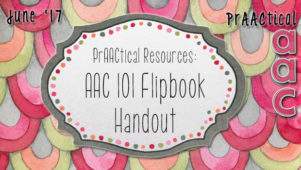
Looking for a quick, easy-to-read resource to supplement your AAC trainings with colleagues and families? In today’s post we share a flipbook-style handout that might come in handy. It covers basic tips under these headings: AAC Near Me (See me, see my AAC) Speak AAC (Aided language input) Speaking Style (Descriptive talking) Expectations (Setting the bar high) Support (AAC facilitation strategies) FAQs (Q & A about implementation) Top 10 Tips You can download the file here. Edited: This was translated into Spanish as part of the Hablando PráctiCAAmente project, coordinated by Deanna Wagner. Dianna Angeles was the translator and Claudia Marimón assisted with the editing. You can access the Spanish edition here. Enjoy!
July 27, 2016
by Carole Zangari -
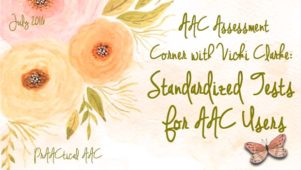
Do you have a love-hate relationships with formal testing? Are you required to use normed tests with your minimally verbal clients? Looking for recommendations on which tests to use? AAC specialist Vicki Clarke has you covered! Like many of you, I’ve had mixed feeling when it comes to using normed assessment instruments with my AAC learners, particularly when we needed to modify the test materials or administration procedures in order for them to be able to participate and respond. If the client can’t point to pictures, give a verbal response, or sit through an entire test, we have no choice but to adapt how the test is administered. As we all know, when we adapt test materials (e.g., putting the test items on an eye gaze board) or procedures (e.g., partner-assisted scanning), we lose the ability to use the normative data. We can, though, compare our learners to themselves at... [Read More...]
May 16, 2016
by Carole Zangari -
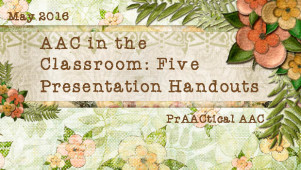
Looking for ideas on how to strengthen language learning by students with AAC needs in the classroom? Here are some presentation handouts that may spur your thinking. Start Talking in Class: Helping Students Using AAC Devices by Gail M. Van Tatenhove Incorporating AAC Use into the Classroom by Karen Vinson and Eleanor Thompson Aided Language Stimulation and the Descriptive Teaching Model by Gail M. Van Tatenhove Communication Peeled and Cored for the Classroom by Jennifer M. Ro and Amy Thomsen Score with Core: Implementing Core Vocabulary in the Classroom by Janet S. Lehr
May 9, 2016
by Carole Zangari -
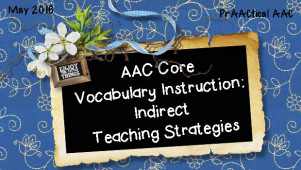
It has been so exciting to see that AAC learners are increasingly provided with communication boards, books, SGDs, and apps that feature a robust set of core vocabulary words. For many years, ‘providing AAC’ used to mean access to topic and choice boards or activity-specific communication displays (ABCDs). Now, we recognize the limitations of those approaches and do our best to move beyond them in favor of more linguistically robust options. AAC systems with core vocabulary that is organized to support the development of a motor plan allows learners to build and grow their skills over time. For a long time, the AAC field has known that providing access to appropriate tools (in this case, a core vocabulary set) is only the first step toward successful use of augmentative communication. Providing it is necessary but not sufficient for most AAC learners to develop any sort of linguistic competence. For... [Read More...]
April 23, 2015
by Carole Zangari -
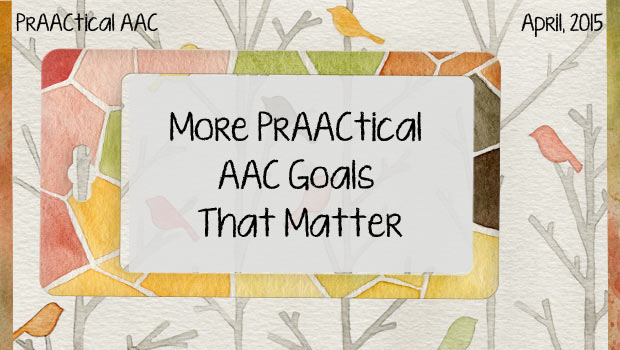
While we may play a variety of roles, a commonality among those of us on teams serving individuals with AAC needs is that we often struggle with developing goals that are meaningful. Let’s work together to develop a list of potential goals that we can reflect on as we work with our clients and their families on a plan for becoming more competent communicators. There are two sections in this post: Qualifiers (for information applying to all goals) and Goal Areas (for actual goals). This is not meant to be a comprehensive list but rather a starting point for a collaborative document. Please join the effort by adding goals in the comment area below or reaching out using our contact form. SECTION 1: QUALIFIERS Each goal can be prefaced with a description of the communicator’s AAC system or the elements of that system can be named. Terms used in this document... [Read More...]
December 9, 2014
by Carole Zangari -
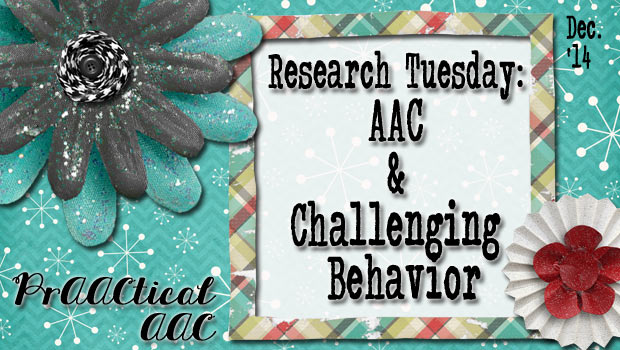
Research reviews are helpful tools for SLPs looking to implement evidence-based practices in their clinical work. In this month’s Research Tuesday post, we look at the work of Drs. Virginia Walker and Martha Snell, who conducted a meta-analysis to look at the relationship between challenging behaviors and AAC interventions. They looked at 54 different research studies with a total of 111 children and adults with AAC needs. They conducted both analytical and descriptive analyses. The research studies included participants at the emerging, prelinguistic, and multi-word levels of communication. Challenging behaviors were codes as distracting, disruptive, and/or destructive. Effect sizes were calculated using the Non-overlap of All Pairs method. Among their findings: AAC interventions reduce challenging behavior across a wide range of participants, including children and adults with a variety of developmental disabilities. AAC interventions were more effective with children (12 and under) than they were with adults (18 years and... [Read More...]
February 11, 2014
by Carole Zangari -
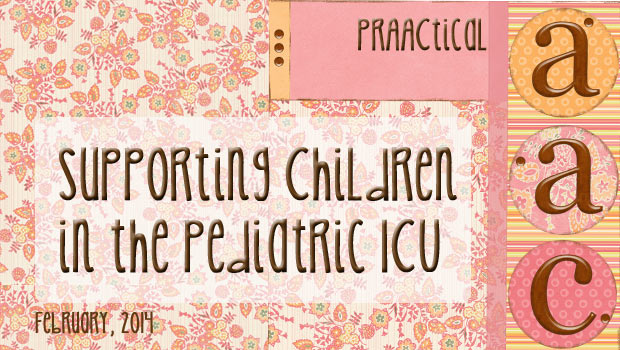
If there is anything scarier than having a very sick child in the ICU, it has to be when that child has no means of communication. In this Research Tuesday post, we join the efforts spearheaded by Rachel Wynn of Gray Matter Therapy to share an article that discusses the issues and presents some solution strategies. When we think of research studies in SLP, we think of experimental designs and randomized controlled trials (RCTs). In AAC, group research designs are uncommon because of the immense heterogeneity of this clinical population. Even limiting the study to one single disorder and age group, say teenagers with dysarthria secondary to cerebral palsy, contains too much heterogeneity for most group research. Instead, we see more single subject design experimental studies (SSEDs) in AAC. When well-designed, SSEDs have strong experimental control and allow researchers to answer causal questions, such as “did the treatment (e.g., teaching... [Read More...]
November 14, 2013
by Robin Parker -
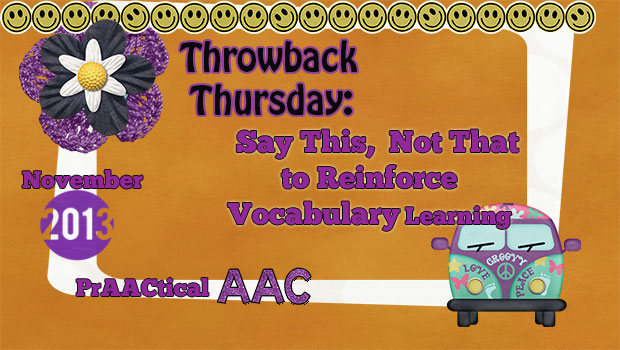
Vocabulary Reinforcement- Worth Repeating (originally published 11/15/12) Part of TEACHING vocabulary to AAC users (or any learner) involves reinforcement. Reinforcement is more than just facilitating positive self esteem. It is also about providing feedback that will help increase the skill you are trying to teach. It’s more than learning specific new words but also about strategies to attack learning new words outside of the therapy or classroom environment. Below are some examples of ways to make the most of your reinforcement and some ways to NOT. (click for some great written reinforcement examples). 🙂 SAY THIS… General Principles of Reinforcement for Vocabulary: Be specific to the goal. Use words that explain the skill you want to occur more often. Use excited positive vocal inflection, Be impressed! We are continuing with the example of teaching the word consumed from Carole’s post on Monday, What Makes A Good Vocabulary Teaching Activity. ‘Wow you discovered a... [Read More...]
August 31, 2013
by Robin Parker -
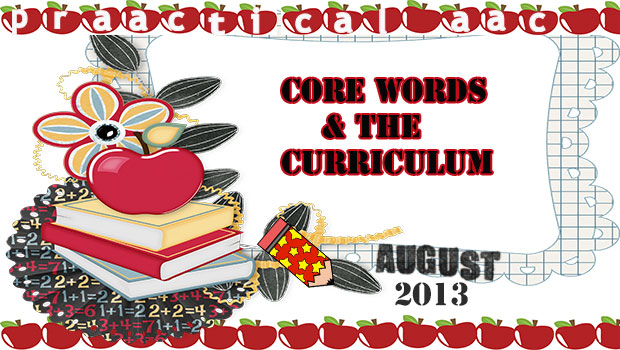
Core words can easily be incorporated into academic curriculum. There just needs to be systematic planning for core word vocabulary and then of course the joining of fringe words. One of the best visual explanations of core words is in the now ‘famous’ you tube video Language Stealers (HD). If you have not seen it, it is worth watching for many reasons but in the context of this post, it perfectly illustrates how you can teach about Greek and Roman history with core words. Planning for Core Words for the Classroom (& ALL School Activities) Have the core word communication board with you at ALL times– If you (SLP/Educator) have your core word communication board, you can model and teach the target core words during all lessons. A premise of this approach is that the student has access to their core word vocabulary display on a no-tech communication board or on their... [Read More...]
March 12, 2013
by Carole Zangari -
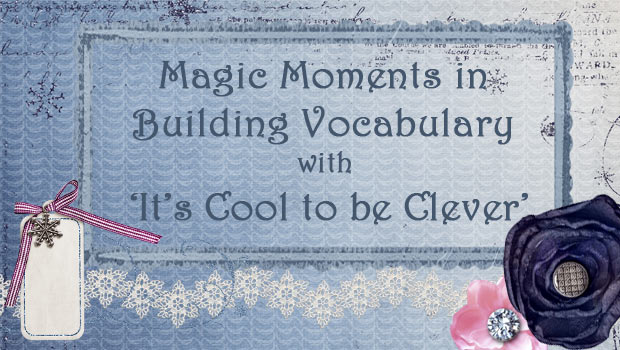
I had such a blast using this great (free) app that I couldn’t wait to get some time to blog about it. ‘It’s Cool to be Clever’ is about being different and uses the story of Edson Hendricks, an innovator who grew up in a small town in Pennsylvania and went on to develop an early design for what we now know as the world wide web. The app is based on a book by a former teacher, Leanne Jones, and contains compelling video and some lovely original music. It was created by Agio Studios. In his own voice, Hendricks tells his personal experiences of growing up feeling different from his peers, family, and community. There are four segments to the app. The Story: Narrated version of Hendrick’s biography, written by Leanne Jones, can be viewed so that you can read on your own, or have it read to you... [Read More...]









